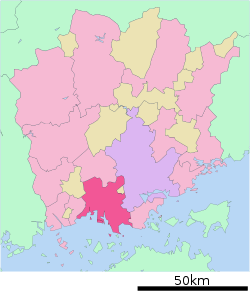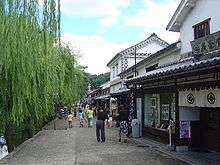Kurashiki, Okayama
| Kurashiki 倉敷市 | ||
|---|---|---|
| Core city | ||
|
Bikan district of Kurashiki | ||
| ||
 Location of Kurashiki in Okayama Prefecture | ||
 Kurashiki Location in Japan | ||
| Coordinates: 34°35′N 133°46′E / 34.583°N 133.767°ECoordinates: 34°35′N 133°46′E / 34.583°N 133.767°E | ||
| Country | Japan | |
| Region | Chūgoku (San'yō) | |
| Prefecture | Okayama Prefecture | |
| Government | ||
| • Mayor | Kaori Itō | |
| Area | ||
| • Total | 354.71 km2 (136.95 sq mi) | |
| Population (December 2012) | ||
| • Total | 477,983 | |
| • Density | 1,350/km2 (3,500/sq mi) | |
| Symbols | ||
| • Tree | Camphor | |
| • Flower | Wysteria | |
| • Bird | Kingfisher | |
| Time zone | Japan Standard Time (UTC+9) | |
| City hall address |
640 Nishinakashinden, Kurashiki-shi, Okayama-ken 710-8565 | |
| Website |
www | |
Kurashiki (倉敷市 Kurashiki-shi) is a historic city located in western Okayama Prefecture, Japan, sitting on the Takahashi River, on the coast of the Inland Sea.
As of December 2012, the city has an estimated population of 477,983 and a population density of 1,350 persons per km². The total area is 354.71 km².
History
The modern city of Kurashiki was founded on April 1, 1928. Previously, it was the site of clashes between the Taira and Minamoto clans during the Heian period. It gradually developed as a river port. During the Edo period, it became an area directly controlled by the shogunate. Distinctive white-walled, black-tiled warehouses were built to store goods. During the Meiji Restoration (Japan's Industrial Revolution period), factories were built, including the Ohara Spinning Mill, which still stands as the nostalgic tourist attraction Ivy Square.[1]
On August 1, 2005, the town of Mabi (from Kibi District), and the town of Funao (from Asakuchi District) were merged with Kurashiki.
Attractions

Kurashiki is the home of Japan's first museum for Western art, the Ohara Museum of Art. Established in 1930 by Magosaburō Ōhara, it contains paintings by El Greco, Monet, Matisse, Gauguin, and Renoir. The collection also presents fine examples of Asian and contemporary art. The main building is designed in the style of Neoclassicism.
The old merchant quarter is called the Bikan historical area. It contains many fine examples of 17th century wooden warehouses (kura, 倉) painted white with traditional black tiles, along a canal framed with weeping willows and filled with koi. The area has no electric poles in order to make it more closely resemble the look of the Meiji period. One of the city's former town halls was located in the Kurashiki Kan, a European style building constructed in 1917.
In 1998 a theme park called Tivoli (after the park of the same name in Copenhagen) opened near Kurashiki Station. After ten years of operation it was closed in 2008, with a massive debt.
The Great Seto Bridge connects the city to Sakaide in Kagawa Prefecture across the Inland Sea.
Kenzo Tange, winner of the 1987 Pritzker Prize for architecture, designed the former Kurashiki City Hall in 1960.
Education
Colleges and universities
The city is home to several private universities and one public university.
- Kurashiki University of Science and the Arts
- Kurashiki Sakuyo University
- Kawasaki College of Allied Health Professions
- Kurashiki City College (public)
- Okayama College
- Kawasaki University of Medical Welfare
- Kawasaki Medical School
- Kawasaki Medical University
Primary and secondary schools
The city has a North Korean school, Okayama Korean Elementary and Junior High School (岡山朝鮮初中級学校).[2]
Sports
Kurashiki has a variety of Sports clubs, including former Japan Football League side Mitsubishi Mizushima.
- Mitsubishi Motors Mizushima FC - Soccer
- JX Nippon Oil & Energy Mizushima F.C. - Soccer
- Kurashiki Oceans - Baseball
- Kurashiki Peach Jacks - Baseball
Sister/friendship cities
Kurashiki maintains the following sister/friendship cities:[3]
-
 Sankt Pölten, Austria, September 29, 1957
Sankt Pölten, Austria, September 29, 1957 -
 Kansas City, Missouri, United States since May 28, 1972
Kansas City, Missouri, United States since May 28, 1972 -
 Christchurch, New Zealand, March 7, 1973
Christchurch, New Zealand, March 7, 1973 -
 Zhenjiang, China, November 18, 1997
Zhenjiang, China, November 18, 1997
Notable people from Kurashiki
- Ahn Young-Hak, Japanese-born North Korean football midfielder
- Senichi Hoshino, baseball player[4]
- Keitarou Izawa, a.k.a. Ichiyo Izawa, pianist, frontman of Appa and former member of Tokyo Jihen
- Kibi Makibi, scholar and noble during the Nara period
- Magosaburō Ōhara, businessman and philanthropist[5]
- Yasuharu Ōyama, shogi player, the 15th Lifetime Meijin[6][7]
- Daisuke Takahashi, figure skater[8]
- Joichiro Tatsuyoshi, boxer
- Makiko Ohmoto, voice actress
References
- ↑ "Kurashiki's History". City of Kurashiki. August 7, 2006.
- ↑ "ウリハッキョ一覧" (Archive). Chongryon. Retrieved on October 14, 2015.
- ↑ Kurashiki's Sister/Friendship Cities
- ↑ 星野仙一記念館 [Hoshino Senichi Memorial Hall] (in Japanese). Kurashiki Convention & Visitors Bureau. Retrieved 2 October 2014.
- ↑ 大原孫三郎から現代まで [From Magosaburo Ohara to the present] (in Japanese). Ohara Museum. Retrieved 2 October 2014.
- ↑ 7 大山名人記念館(倉敷市芸文館内 (in Japanese). Kurashiki City. Retrieved 30 September 2014.
- ↑ 棋士紹介:物故棋士一覧 (in Japanese). Japan Shogi Association. Retrieved 30 September 2014.
- ↑ ひと、輝くまち (PDF). 広報くらしき (in Japanese) (February, 2006): 29. February 1, 2006. Retrieved 2 October 2014.
External links
| Wikimedia Commons has media related to Kurashiki, Okayama. |
| Wikivoyage has a travel guide for Kurashiki. |
- Kurashiki City official website (Japanese)
- Kurashiki City official website
- Ryokan Kurashiki website
- Kurashiki's Sister/Friendship Cities
